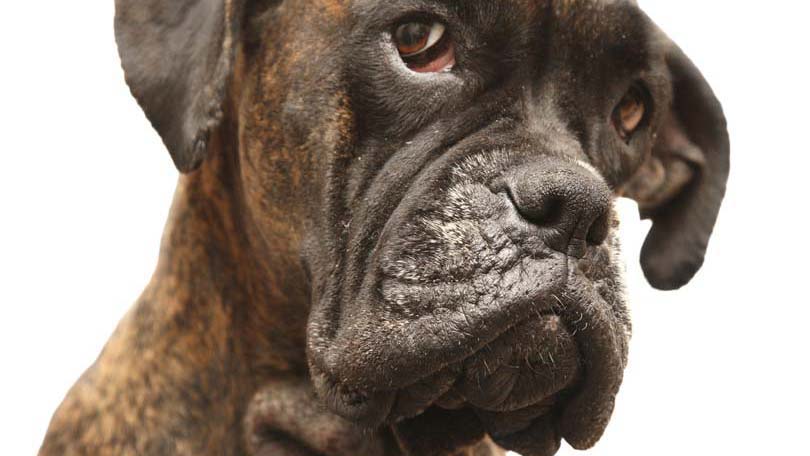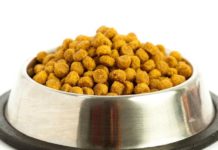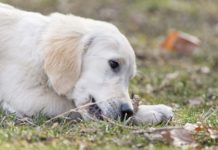
Any dog owner can tell you that it really isn’t all that unusual for your puppy to develop behaviors that just seem a little off base. From your point of view, you have given him everything that he needs to be a happy and healthy dog with that storybook loyalty that we all secretly expect from our dog. Behaviors such as cutting you off while walking, pulling on the leash, and growling around food are all indicative of a dog who is posturing for leadership. From a human standpoint, it doesn’t make much sense.
Dogs are always looking for their humans to be their leaders. While they almost never accept leadership from kids, they are seeking to understand their place in the pack, where they belong, the same way the human members of the family do. And just like their human family, when their place is unclear they will test a few boundaries to see exactly where they stand.
Growling around food is one of the potential behaviors that can be simply undermined during their developmental stages as a puppy. If you are trying to prevent the behavior, you need to start young, or as young as possible. During his meal times simply reach down and take the bowl from him. Lavish him with praise and return the bowl every time he permits it. Correct him and keep the bowl for at least ten minutes if he shows the slightest sign of aggression.
Humans recognize feeding time, whether we are feeding our animals or our people, as an act of love and nourishment. Dogs see feeding time as a necessity for life sustaining nutrients as well as a method of reinforcing his place in the pack. Your puppy isn’t likely all that interested in how your day went while he is eating his meal, he is simply looking for his right to his food and usually doesn’t even seem to be tasting it on the way down. (This is because dogs “taste” more via smell than their taste buds.)
A standard “pack” adheres to a set standard pertaining to food distribution. The leader is the one who is permitted first grab at the food, whether or not he had anything to do with the actual providing. In his human family, signals can easily get crossed. Sometimes a dog might eat before his humans and other days he might eat after his humans. Perhaps there is no schedule and he just eats whenever he feels the urge for a little nibble. While free feeding might allow some dogs the essential freedom they need it can foster aggressive tendencies in other dogs. Dogs who feel a need to assert their leadership over their own food are the ones who are more likely to growl or even snap if he feels his vital nutrients are being threatened.
There are usually other accompanying warning signs that crop up before the growling begins, even during puppy—hood. Often a dog who feels his food is threatened will not leave his dish unprotected if there is still some kibble in there. Other dogs might pace incessantly, guarding his food. A dog who is relaxed about his food is going to feel comfortable walking away, allowing it to exist out of his line of sight and even out of his line of thought.
Training Your Dog Not To Growl When Eating Their Food
There are some new methods (often combined with older methods) for combating food aggression. Once upon a time the humans thought that a dog had a right to protect his food. Perhaps if you have a dog living in a household with a bunch of other dogs, you might expect this behavior. However, that doesn’t make it acceptable. And it is certainly never acceptable to growl at the human who wants to move his dish.
The basic goal of being your dog’s nutritional leader is rather simple in theory but takes a significant commitment from you, especially if the growling is hypersensitive and there is a likelihood that it will be followed up by a snap. Your dog needs to have the impression that you are his leader, and that he is only entitled to the remnants of what you don’t want. This is an attitude that you need to portray for your dog. You don’t actually have to eat the food first.
Start by eating your meal first. If you aren’t eating at home, feed him early after you sit down at the table for a quick snack. Even if you are eating late, eating take out, eating early, or eating a handful of grapes for dinner you need to eat first. Try to maintain a certain consistency about your eating habits, like eating in the same place every night.
Remember that you are the leader, so he gets nothing, not even a table scrap, until you are completely finished with your own food. If you are the type who likes to give your sweet pup a little something from your plate, that’s fine. You will simply do it differently right now. Never from the table and never while you’re still eating. You should order your dog out of the same room and make him go lie down. It’s okay if he can see you, but what you don’t want is silent begging. If you eat in the kitchen, teach him to go out of the kitchen and lie down. If you eat in the living room, same idea. If he begs from the other room, send him farther away. While you are both learning this, your food is likely to grow cold while you deal with the dog, but that is a small price to pay for a dog who is about to learn that you can snatch his food out from under him.
When you are completely finished, which includes your cup of coffee or tea, then fill their bowl and allow it to sit out of reach for a few minutes while you go through your clean up routine. By now, he should be aware that you are going to feed him. When you are ready, and he has waited, make him sit and wait for you to tell him that he may approach his bowl. Place it in his eating area and walk completely away, giving him the clear signal that you are now done with it so he may as well have it. If you are a table scrap treater, it would be better to plop the table scrap treats in his dish. From his sit and stay, on your way out of the area, tell him his release word such as “okay” or “free.”
As you establish your leadership in this area, you should start to see a more relaxed attitude regarding his behavior toward his food. This alone should help reduce the growling around food. However, your work is not complete until you can take away his food, or allow another pet to walk by him, without hearing so much as a peep.
As the growling around food behavior starts to improve, start walking by him, as though you aren’t interested in him or his food. After a few days, repeat the behavior and the walk up to him. If he doesn’t growl, lavish some praise and walk on. If he growls, correct him. When he reaches three days in a row without a growl, repeat the process adding a pet on the head. When he is growl free for three days with a simple pet on the head, reach down and put an additional treat in his food. When you have successfully been able to walk around, pet him and reach down with an extra treat for him daily for three days without a single growl or correction, your final step is to take his food away from him while he is eating. Keeping a strong posture and a leader focused mentality will help to break the growling around food problem. It may take some time, but slowly taking back your authority is still the fastest way to a successful outcome.





